Beards vs Mustaches Tournament
Here's the Big Hairy Deal you’ve been waiting for. The Wisconsin Veterans Museum March Madness Beards vs Mustaches Tournament begins.
From March 15th until April 3rd the finest Wisco whiskers will face off each weekday. You, our loyal fans, will determine the finest facial hair in the collection by giving a thumbs up on the photo of your favorite mustache or beard of the day. The championship pits the best beard against the most marvelous mustache.
This contest will take place on our Facebook page and in our Instagram story each weekday.
The Glorious Beards
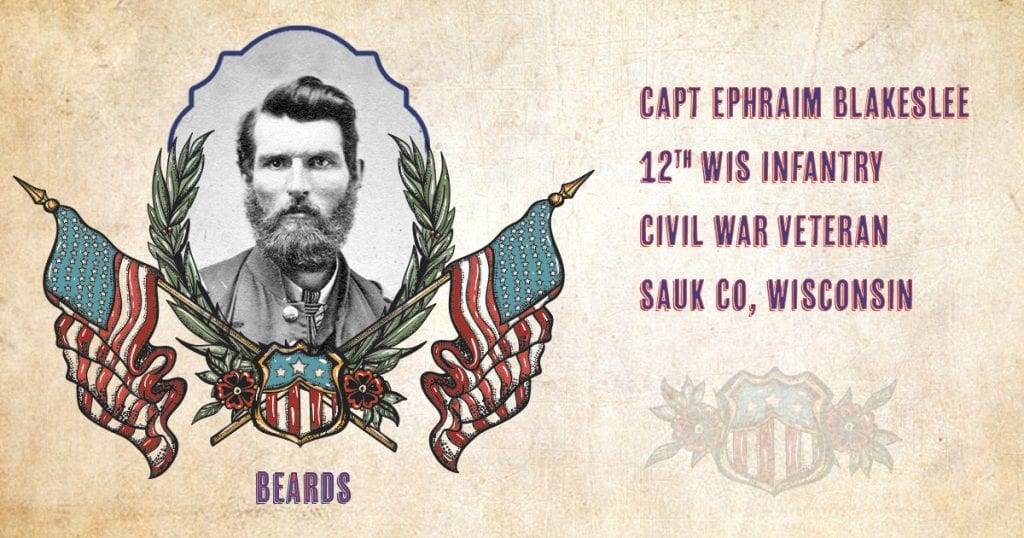
Captain Ephraim Blakeslee
Ephraim Blakeslee was born in Fenner, New York on May 12, 1838 and as a young child moved with his family to Wisconsin, where they settled near Ironton in Sauk County. He grew up tall and strong on the family farm, standing an imposing 6 feet tall with brown hair and brown eyes. At the age of 23, he married Mary Ballard and six months later, in September 1861, volunteered to serve in the Union Army.
He joined Company B, 12th Wisconsin Infantry Regiment as a 1st Sergeant and served in that capacity until accepting a commission as 2nd Lieutenant of Company H in May 1862. He was promoted to 1st Lieutenant of the company in January 1864 and in August, he was detached to command Company E. A member of that company, Hosea Rood, later wrote about Blakeslee, “We liked him very much… I think all our men who marched to the sea would vote with both hands that Eph. Blakeslee was not only a most excellent company commander, but a royal good fellow, besides.” As alluded to by Rood, Blakeslee took part in the Atlanta campaign, the March to the Sea, and the Carolina campaign with the 12th Wisconsin. In April 1865, he received a promotion to Captain of Company H, and was mustered out with his men in July.
Returning to Sauk County, Blakeslee sold the family farm and moved into Ironton, where he engaged in the mercantile trade. He and his wife Mary had three children before she passed away in 1871. He married Caroline Swift two years later. Blakeslee passed away on February 22, 1911 and is buried at Resting Green Cemetery in Ironton.
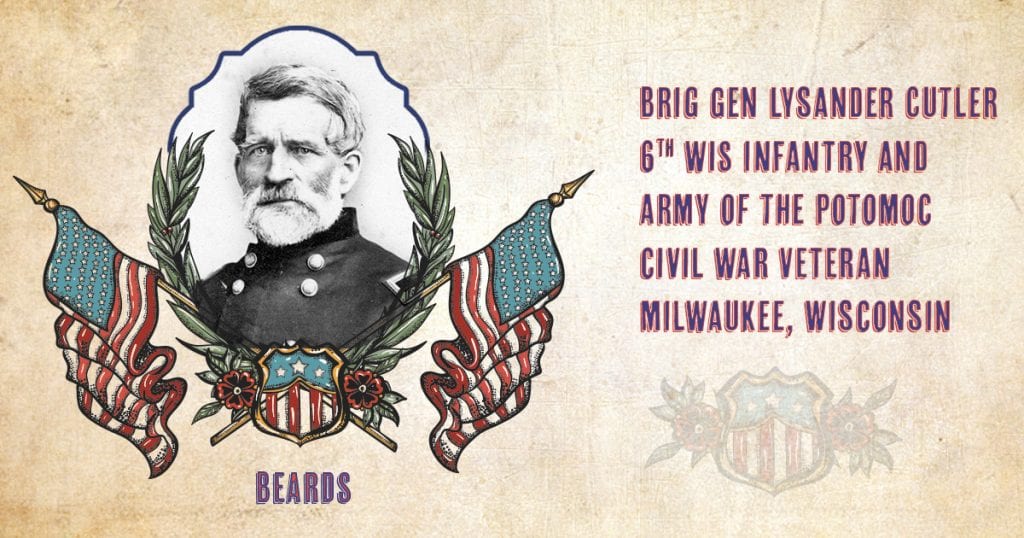
Brigadier General Lysander Cutler
Lysander Cutler was a fifty-four year old man living in Milwaukee when the Civil War began. Because of the esteem in which he was held and his previous military experience with the Maine militia, he was commissioned Colonel of the 6th Wisconsin Infantry Regiment, which would become part of the famous Iron Brigade.
If there were any doubts about his abilities because of age, they were quickly erased by his performance at the Battle of Gainesville. It was there that Cutler was severely wounded in his right leg while leading his men against Stonewall Jackson. The wound,
which limited his mobility, also caused him to miss the battle of Antietam. Following the battle of Fredericksburg, Cutler was promoted to Brigadier General and assigned to the Ar 1st Division, I Corps. That unit saw heavy action on the first day of fighting at Gettysburg, suffering heavy losses.
Cutler led the entire 4th Division of the Army of the Potomac into battle at Globe Tavern in August 1864 and was wounded severely when a shell fragment struck his face. Unable to serve in the field any longer, he helped organize troops in New York and Michigan before resigning his commission as brevet Major General in July 1865. Cutler returned to Milwaukee and died of a stroke on July 30, 1866. He is buried in Forest Home Cemetery.
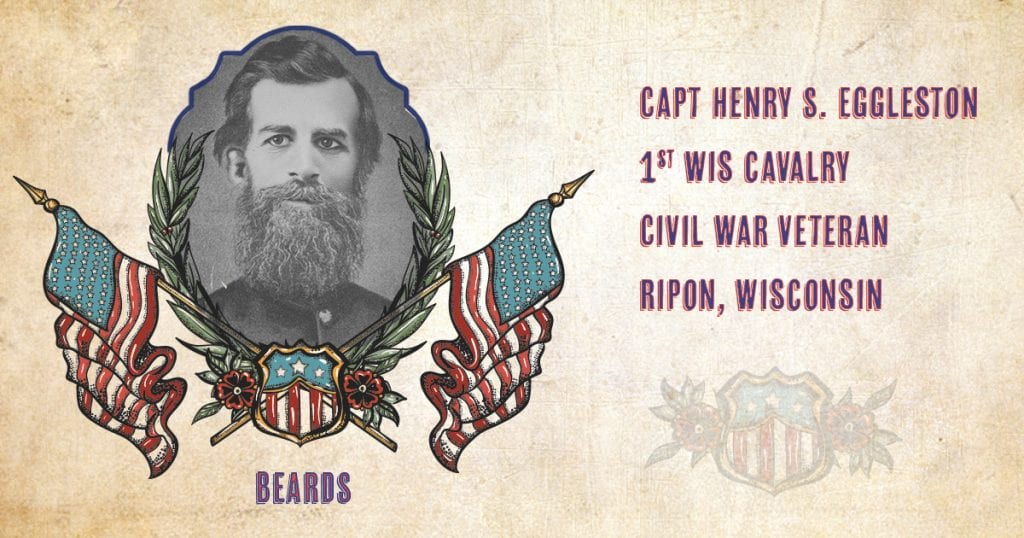
Captain Henry S. Eggleston
Henry S. Eggleston was born in Vermont in 1820 and immigrated to Wisconsin in 1850. He married Elizabeth Washburn on May 6, 1845 and the couple had 3 daughters. A prominent citizen of Ripon, Wisconsin, he established Eggleston's Real Estate, Insurance, Loan and Collection Agency and served as postmaster of Appleton, Wisconsin prior to the war. On August 15, 1861, at the age of 41, Eggleston enlisted into Company B, 1st Wisconsin Cavalry Regiment, also known as the Ripon Guards.
On August 22, 1861, Eggleston received a commission as Captain and traveled to Camp Harvey in Kenosha, Wisconsin for training. He was promoted to Major in July 1862. Eggleston and his men engaged in skirmishes in Missouri and Arkansas, including the Skirmish at L’Anguille Ferry near Marianna, Arkansas. Due to an illness contracted while stationed in Missouri, Eggleston relinquished field duty in the fall of 1862 and took up recruiting service. On December 11, 1862, Major Henry S. Eggleston died suddenly of diphtheria in Milwaukee, Wisconsin. He is buried in Hillside Cemetery in Ripon. After the war, Ripon veterans named their Grand Army of the Republic Post the Henry S. Eggleston Post No. 199 in his honor.
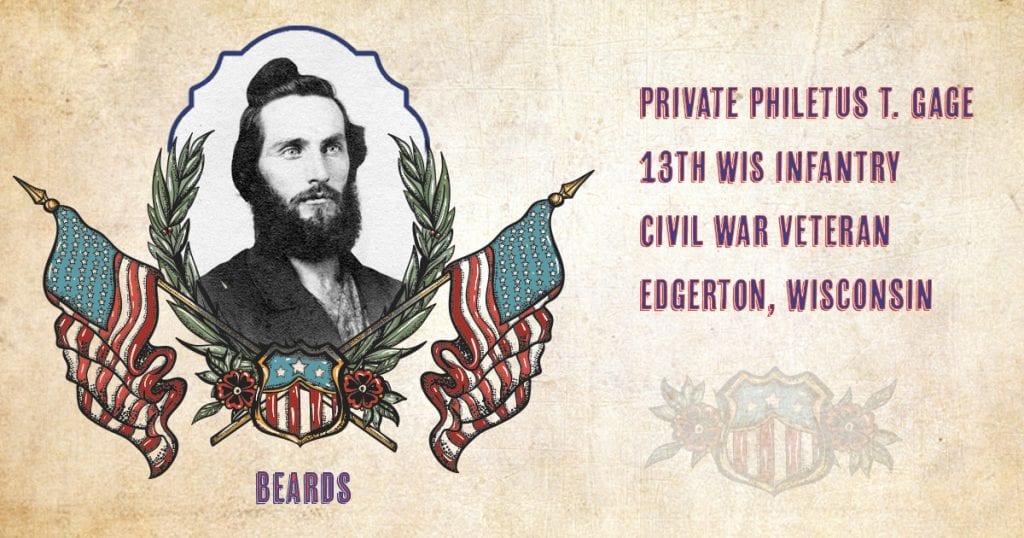
Private Philetus T. Gage
Philetus T. Gage enlisted with Company F, 13th Wisconsin Infantry on September 27, 1861 as a Private. Philetus was born on April 7, 1838 in Freedom, New York. He married Amelia Gage in 1859 and together they had two girls and a boy. At the time of enlistment Private Gage was a 23 year old farmer living in Edgerton, Rock County, Wisconsin. He would have been considered tall, standing 5 feet 11 inches, had black eyes, brown hair, and a fair complexion. Private Gage served with his company without incident and was mustered out of service, term expired on November 21, 1864.
During his service, he took part in the protection of lines of communication in middle Tennessee and Kentucky, and Northern Alabama. After the war, Gage continued to farm and he and his family moved for a short time to Wyoming before settling in LaMotte, Michigan. Gage’s wife Amelia passed away in 1900 and he followed July 16, 1909. Philetus T. Gage is buried at Moshier Cemetery in Herman, Michigan.
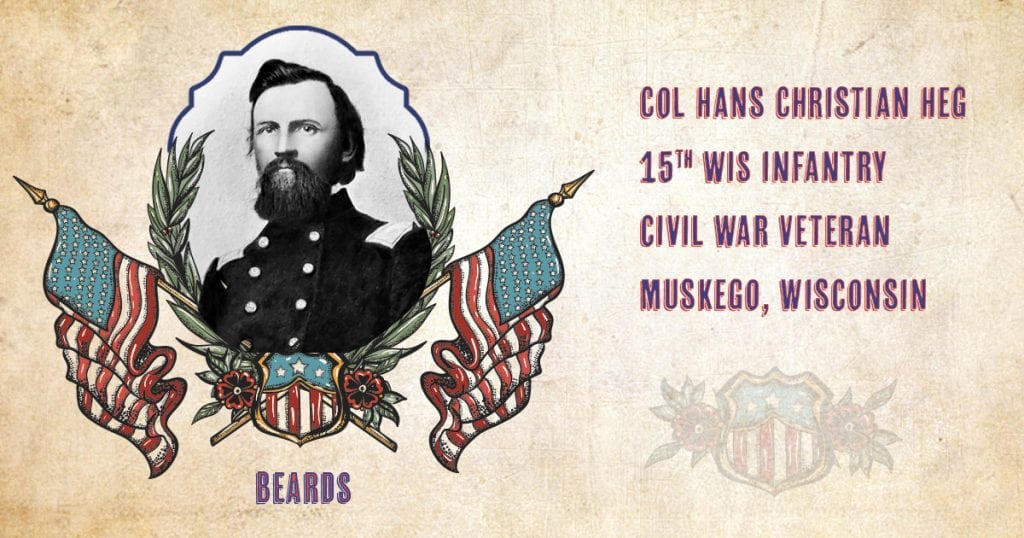
Colonel Hans Christian Heg
Hans Christian Heg was born in Norway on December 21, 1829. At the age of eleven, he immigrated with his family to the United States and moved to Muskego, Wisconsin, where his family took up farming. With the discovery of gold in the late 1840s, Heg joined the rush and traveled to California to seek his fortune in gold. The death of his father compelled Heg to return to Muskego to tend the family farm and his siblings since his mother had predeceased his father. Heg soon married and entered local politics where he was regarded as a “rising young politician,” Heg was elected to the office of commissioner of the state prison at Waupun in 1860, radically improving the prison system. In 1898, his son James would continue that tradition at the newly created Wisconsin State Reformatory in Green Bay, where he served as the institution’s first superintendent.
In 1861, Governor Randall commissioned Heg to Colonel of the Fifteenth Wisconsin Volunteers, a new regiment made of primarily Scandinavian immigrants. The Fifteenth Wisconsin trained at Camp Randall for sixteen days before they were ordered South on March 2, 1862. Often called, “The Fighting Fifteenth,” one third of the entire regiment died during the war from wounds and disease, including Heg who died on September 20, 1863, from a wound received while leading a charge the day before at the battle of Chickamauga. In memory of Heg for his heroism, a statue was erected in his honor and sits on the grounds of the state capitol building.
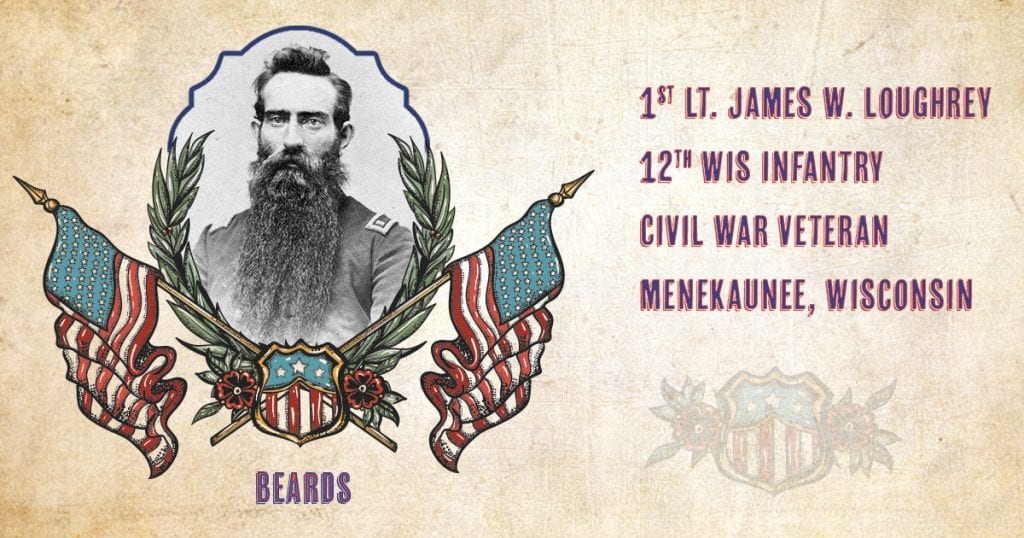
1st Lieutenant James W. Loughrey
James W. Loughrey enlisted into Company F, 12th Wisconsin Infantry Regiment on October 14, 1861. At the time, he was a 31 year old civil engineer living in Menekaunee, Wisconsin (later incorporated into the city of Marinette). He stood a little over 5"5" tall, had blue eyes and brown hair, and was not married. He was promoted to sergeant about a month after enlisting. He chose to re-enlist in August 1864 and was quickly thereafter promoted to 1st Sergeant, 2nd Lieutenant, and in January 1865 to 1st Lieutenant of Company F.
During his service, he took part in actions including the siege of Vicksburg, the Meridian Expedition, the Atlanta campaign, the March to the Sea, and the Carolina campaign. With the rest of the 12th Wisconsin, he took part in the Grand Review of the Armies in Washington, DC and he was mustered out of service on July 16, 1865. He returned to Marinette and worked in the lumber industry for several years. He opened a hotel in 1869, but lost it two years later in the great Peshtigo fire of 1871. Refusing to give up, he built the Exchange Hotel and operated it until his retirement in 1894. He also was married in 1871 to Helen Drew, and the couple had five children: Mary, Charles, Maud, Marion, and Minnie. He passed away on May 11, 1906 and is buried at Riverside Cemetery in Peshtigo.
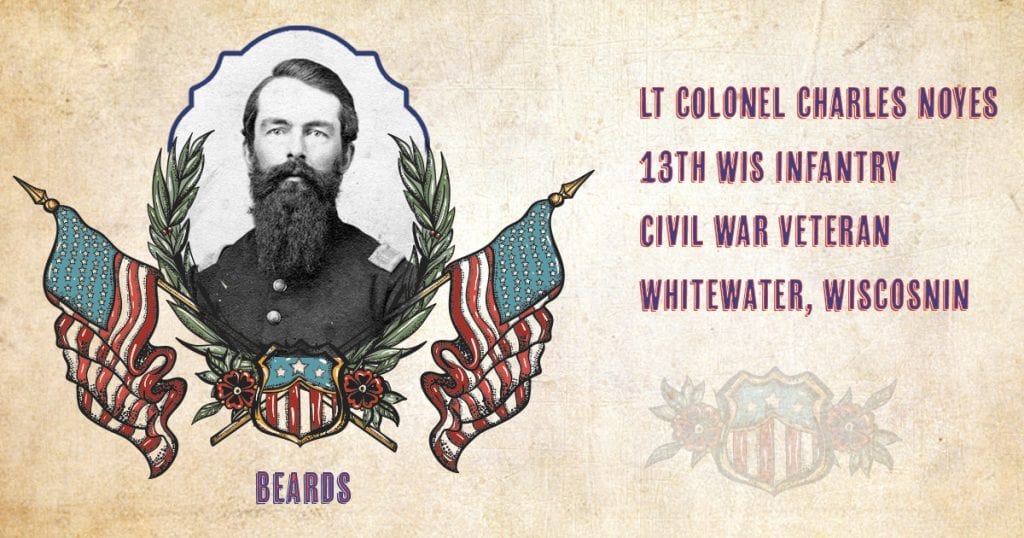
Lieutenant Colonel Charles Noyes
Born November 16, 1832 in the state of New York, Charles S. Noyes moved to Wisconsin with his family around 1850. He operated a saddle and harness business in Whitewater. Noyes enlisted into Company H, 13th Wisconsin Infantry on September 30, 1861. At the time of enlistment he was 29, single, and living in Whitewater. Noyes was commissioned a First Lieutenant on October 18, 1861. Less than a year later on May 14, 1862 he was promoted to Captain, on February 15, 1865 he was promoted to Major, and finally on October 9, 1865 he was promoted to Lieutenant Colonel before being mustered out of service on November 24, 1865.
During his service, he and the 13th Wisconsin Infantry took part in the protection of lines of communication in middle Tennessee and Kentucky, and Northern Alabama. In June 1865, the regiment was sent to New Orleans, Louisiana, then San Antonio, Texas, where they remained on duty until November 24, 1865 when they finally received orders to return to Madison, Wisconsin. As the war came to a close Noyes elected to remain in San Antonio,
Texas, resigning the command to Captain Cobb. Little is known about Noyes’ life after the war. In the 1870s he was living in Houston, Texas.
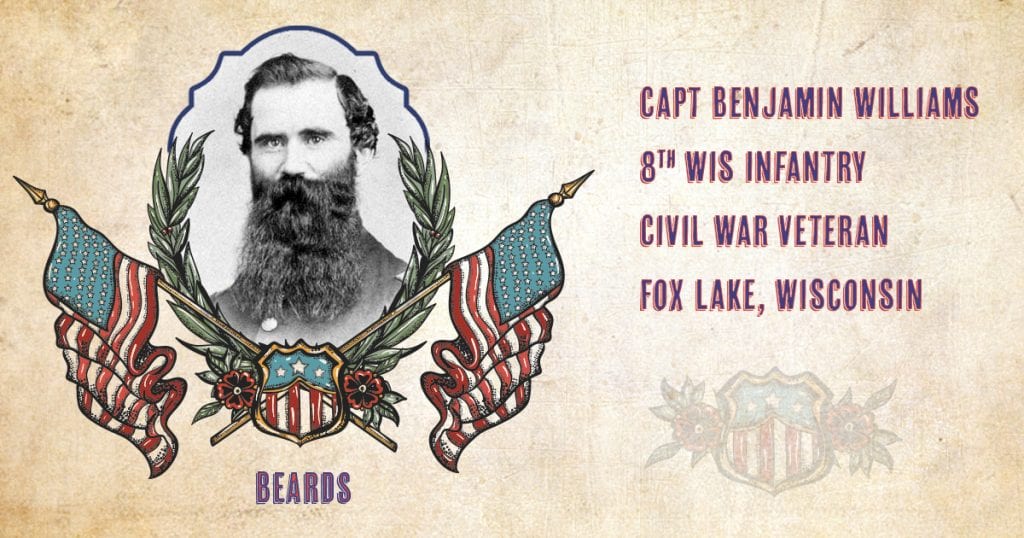
Captain Benjamin Williams
There is a certain amount of mystery surrounding Benjamin S. Williams. His muster and descriptive roll states that he was born in Trenton, New York while the 1860 Census lists the country of Wales as his birthplace. Both sources, however, agree that he was living in Fox Lake, Wisconsin at the state of the Civil War. The 29 year old merchant stood 5’8½” tall with sandy hair and hazel eyes. He enlisted into Company D, 8th Wisconsin Infantry Regiment on July 18, 1861 and impressed his superiors enough to receive a commission as 1st Lieutenant less than two weeks later.
While training at Camp Randall, Williams certainly would have seen Company C’s mascot, the famous bald eagle named Old Abe. As part of the “Eagle Regiment,” Williams saw significant action in the Western Theater at places like New Madrid, Island No. 10, Iuka, Corinth, and the Siege of Vicksburg. Williams commanded Company D through much of the war when the company’s Captain, William J. Dawes, was unable due to a wound and being held prisoner. Finally, Williams received a formal promotion to Captain, dating from
April 27, 1864. He was wounded slightly at the Battle of Nashville in December 1864 and was mustered out with his company on September 5, 1865. Following his service, the mystery picks up again. We have been unsuccessful in finding out where Williams lived after his service, when he died, or where he is buried.
The Magnificent Mustaches
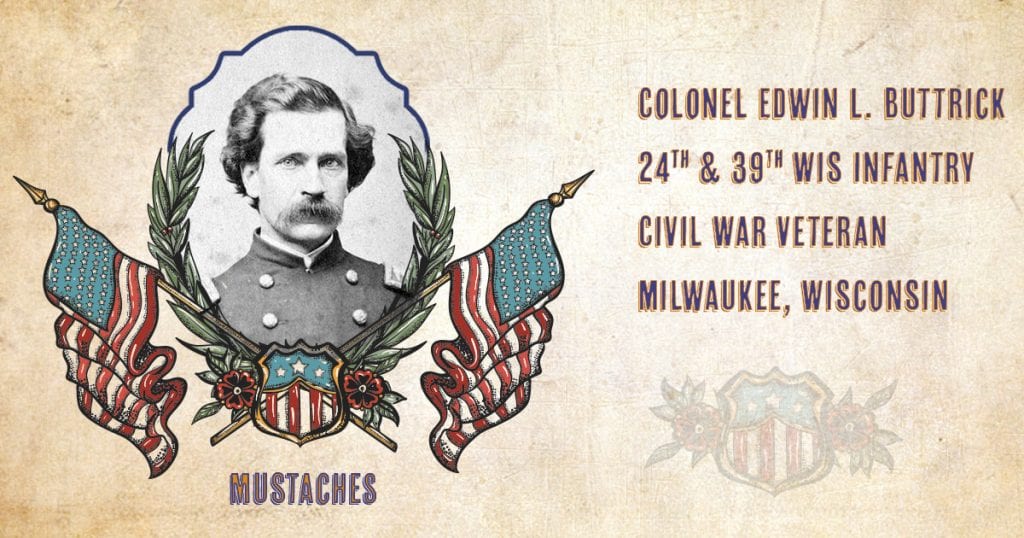
Colonel Edwin L. Buttrick
Edwin L. Buttrick was born on August 5, 1824 in Boston, Massachusetts. He was a school teacher in Kentucky for a time, but by 1850, he moved to Winnebago County, Wisconsin and worked as a lawyer. He married Fanny Burling in 1851 and later he moved to Milwaukee to continue his law practice.
On August 22, 1862, he accepted a commission as Lieutenant Colonel of the 24th Wisconsin Infantry Regiment. At the time, Buttrick was 38 years old and stood 5’9½” tall with blue eyes, light hair, and a light complexion. He took part in the Battle of Perryville, but resigned his commission on December 24, 1862.
A little over a year later, he accepted another commission, this time as Colonel of the 39th Wisconsin Infantry Regiment, a 100 day regiment. Buttrick and the 39th deployed to Memphis, Tennessee to perform guard and picket duty, repelling a raid by Nathan Bedford Forrest on August 21. After serving his 100 days between May and September 1864, Buttrick left the service.
After moving to Chicago for a few years, Buttrick moved to Charleston, West Virginia, where he set up a law practice. His wife Fanny died in 1871, and he married Jane Bigelow in 1873. The couple had one daughter, Mary. Buttrick passed away on November 9, 1908 and is buried in Grafton, Massachusetts.
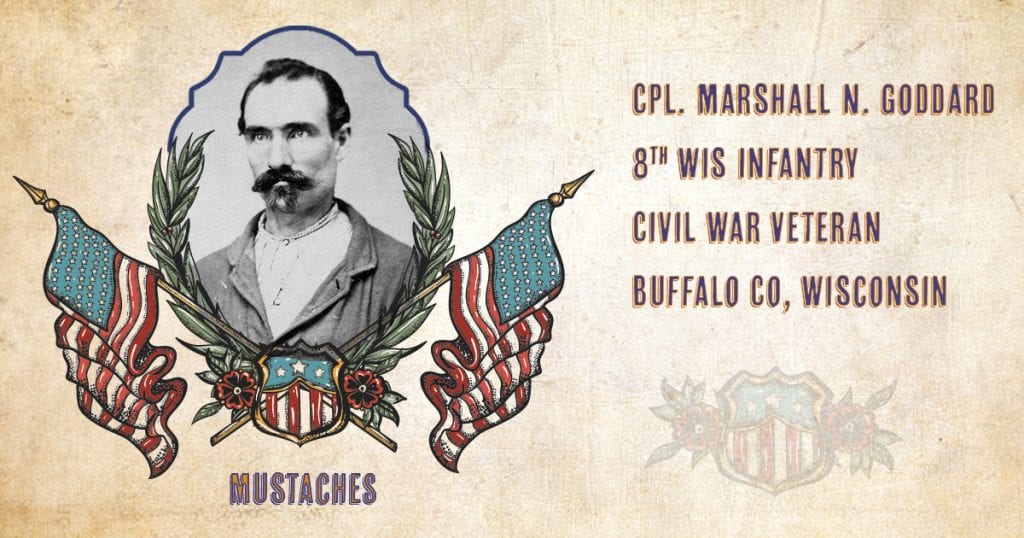
Corporal Marshall N. Goddard
Marshall N. Goddard was born on October 21, 1837 in Canada. In 1850, he was living in Dane County, Wisconsin with his family, but by 1860 he was farming in Buffalo County, Wisconsin. In August 1861, he volunteered to serve with Company C, 8th Wisconsin Infantry Regiment, the company of men who famously purchased a bald eaglet on their way to Madison and named him Old Abe.
The 5’9½” Goddard, with blue eyes, dark hair, and a dark complexion, spent 2 months detached to the 3rd Division Commissary Department in the fall of 1863, but served with the 8th Wisconsin throughout the war. He re-enlisted in 1864 and was mustered out with his company in September 1865.
His life after service is less clear. Goddard’s obituary stated that he worked as a merchant in Buffalo County, but had been in poor health for many years. He passed away on July 27, 1883 at the age of 45 and his burial location is unknown.
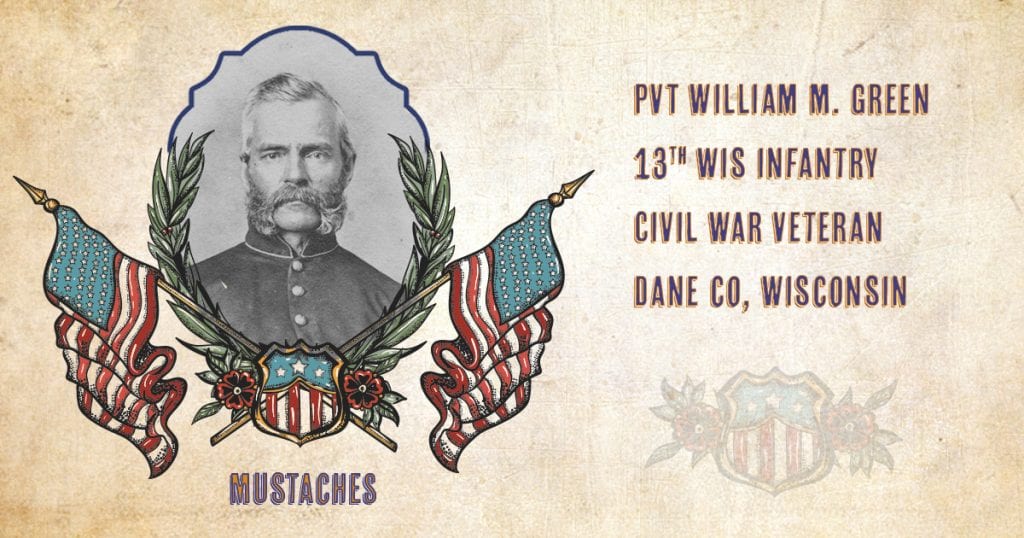
Private William M. Green
William M. Green was born on August 2, 1819 in DeRuyter, New York. He married Abby Crandall in 1841 and was working as a carriage maker in Hopkinton, Rhode Island in 1850. By 1860, he and his family lived in Dane County, Wisconsin, where he worked as a wagon maker.
A 42 year old man who stood 5’9” with hazel eyes, brown hair, and a light complexion, Green volunteered in September 1861 for service with Company A, 13th Wisconsin Infantry Regiment. Serving in and around Forts Henry and Donelson, Green chose to re-enlist in February 1864. However, he grew ill, spent some time in hospitals, and he was discharged with a disability in February 1865.
Records of Green grow sparse after the war. In 1870, he was farming in Dane County but in 1900, he was a resident at the North Dakota Soldiers Home in Lisbon. We are unfortunately unsure when he passed away or where he is buried.
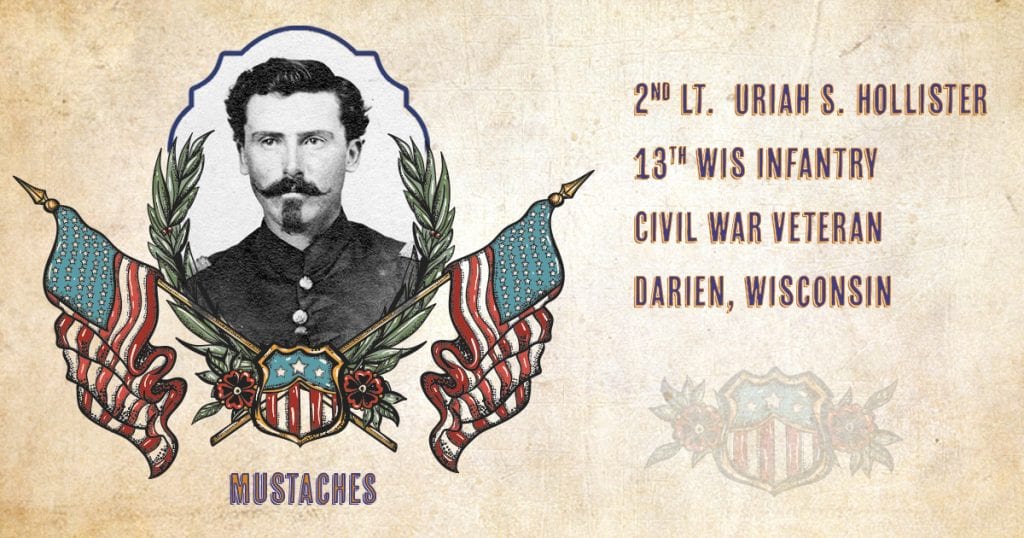
2nd Lieutenant Uriah S. Hollister
Uriah S. Hollister was born on September 11, 1838 in New York but his family moved the following year to Darien, Wisconsin. He grew up on the family farm and was living there when volunteered for service with Company K, 13th Wisconsin Infantry Regiment on October 21, 1861. A tall man at 5’11½”, he had blue eyes, auburn hair, and a light complexion.
He climbed the ranks in his unit from the bottom to the top, commissioned a 2nd Lieutenant in June 1862, receiving special duty assignments related to quartermaster and supplies for the regiment and division, commissioned a 1st Lieutenant in November 1864, and made Captain in February 1865.
Following the war, he married Emma Morrison from Tennessee, whom he likely met during his Civil War service in that state. They remained in Wisconsin for a time, moved west to Minnesota in 1880, but by 1900 were settled in Denver, Colorado, where Hollister held high positions for the Continental Oil Company and later the Era Mining Company. Around 1917, he moved to Los Angeles, California. He passed away there on September 3, 1929 and is buried at the Hollywood Forever Cemetery in Los Angeles.
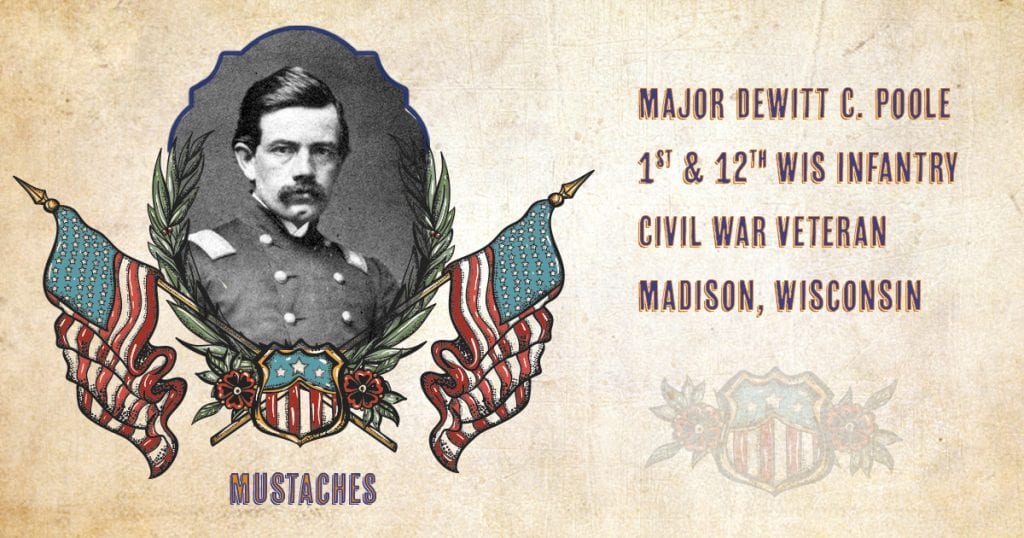
Lieutenant Colonel DeWitt C. Poole
DeWitt C. Poole was born on September 28, 1828 in Amsterdam, New York. He moved to Madison, Wisconsin in 1854 and worked as a merchant. Enlisting on April 17, 1861, three days later he received a commission as Lieutenant with Company K, 1st Wisconsin Infantry Regiment, the very first unit from Wisconsin to serve in the Civil War. Standing 5’6¾” with gray eyes, brown hair, and a fair complexion, Poole served his three month term and returned to Wisconsin.
About a month later, he accepted a commission as Lieutenant Colonel of the newly formed 12th Wisconsin Infantry Regiment. Poole was relieved from active duty in Fall 1863 and joined the Veterans Reserve Corps as an instructor for several months before transferring to the Army of Virginia in June 1864. Shortly thereafter, he was made Provost Marshal of the District of Columbia and placed in charge of President Lincoln’s security for a time.
He resigned from the Army in February 1866, but rejoined in 1867. He spent several years at various posts in the Dakota Territory, New York, and the Washington Territory, rising to the rank of Major. Per Army regulations at the time, he retired on his 64th birthday in 1892. He returned to Madison, where he passed away on November 30, 1917. He is buried at Forest Hill Cemetery in Madison.
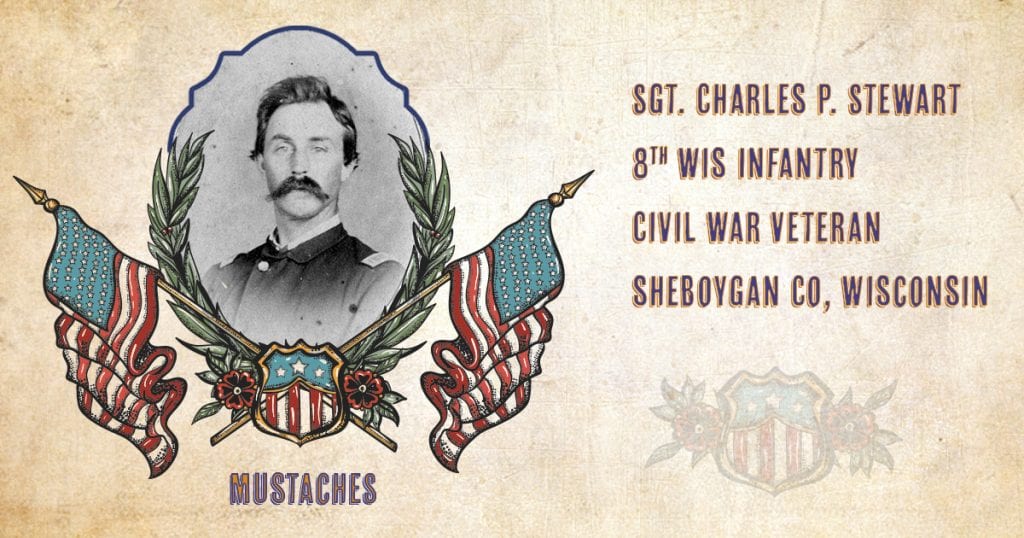
Sergeant Charles P. Stewart
Charles P. Stewart was born on August 23, 1832 in New York. By 1860, he was living in Sheboygan County, Wisconsin. On June 1, 1861, the 5’10”, brown haired, blue eyed farmer volunteered for service in Company B, 8th Wisconsin Infantry Regiment. The 8th Wisconsin was the famous “Eagle Regiment,” with a live bald eagle named Old Abe as their mascot.
Stewart was promoted to Sergeant in September 1861 and participated in numerous battles throughout Missouri and Mississippi, culminating in the Siege of Vicksburg. He re-enlisted in January 1864 and continued with the 8th Wisconsin into Louisiana and eventually to Tennessee. He was wounded in the side during the Battle of Nashville in December 1864 and spent the rest of the war recovering in various Union hospitals. He was discharged as a sergeant on April 30, 1865, but later received some backdated promotions. He received a promotion to 1st Lieutenant, dated back to January 1865 and a promotion to Captain dated back to May 1865.
He and his wife Mary farmed in Wisconsin at least through 1870. By 1880, they had moved to Beadle in the Dakota Territory. We are not sure if Stewart remained out there or returned to Wisconsin, but we do know that he passed away on November 28, 1906 and is buried at Rienzi Cemetery in Fond du Lac, Wisconsin.
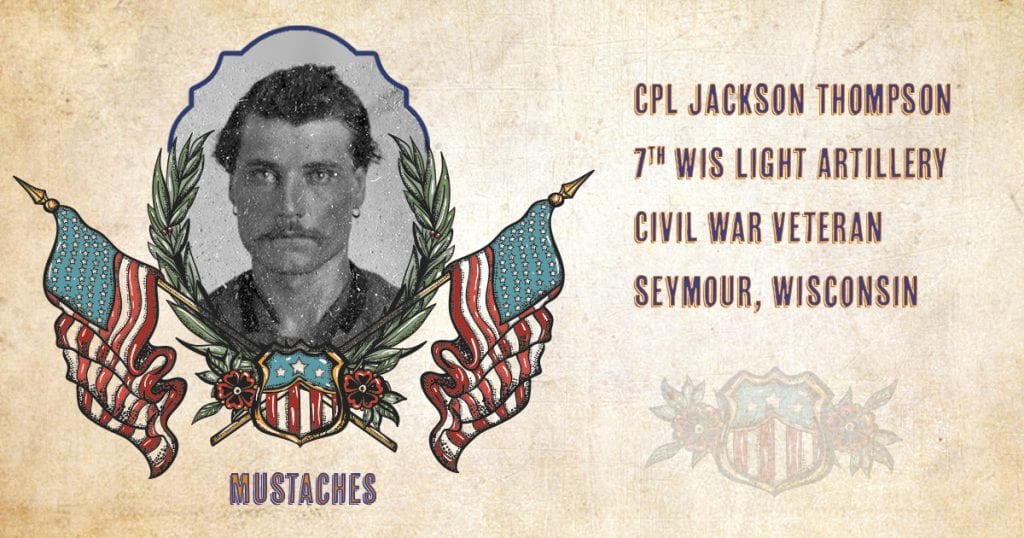
Corporal Jackson Thompson
Jackson Thompson was born on August 13, 1833 in New York. While his given name was Andrew Jackson Thompson, he chose to go by Jackson. By 1850, his family moved to Rubicon, Wisconsin and operated a farm. When he volunteered for service with the 7th Wisconsin Light Artillery Battery in September 1861, Thompson stood 5’8½” tall with gray eyes, brown hair, and a dark complexion. His unit was also known as the Badger State Flying Artillery.
The unit deployed to Missouri, Mississippi, and Tennessee. Thompson was captured during the Battle of Parker’s Crossroads on New Year’s Eve 1862. After spending about 6 months as a prisoner of war, he returned to Union lines as part of a prisoner exchange. He saw out the rest of the war with the 7th Wisconsin Light Artillery.
He was mustered out in July 1865 and married Sarah Thorne three months later. The couple settled in Seymour, Wisconsin and raised three sons while Thompson farmed. He passed away on June 14, 1900 and is buried at Seymour Cemetery.
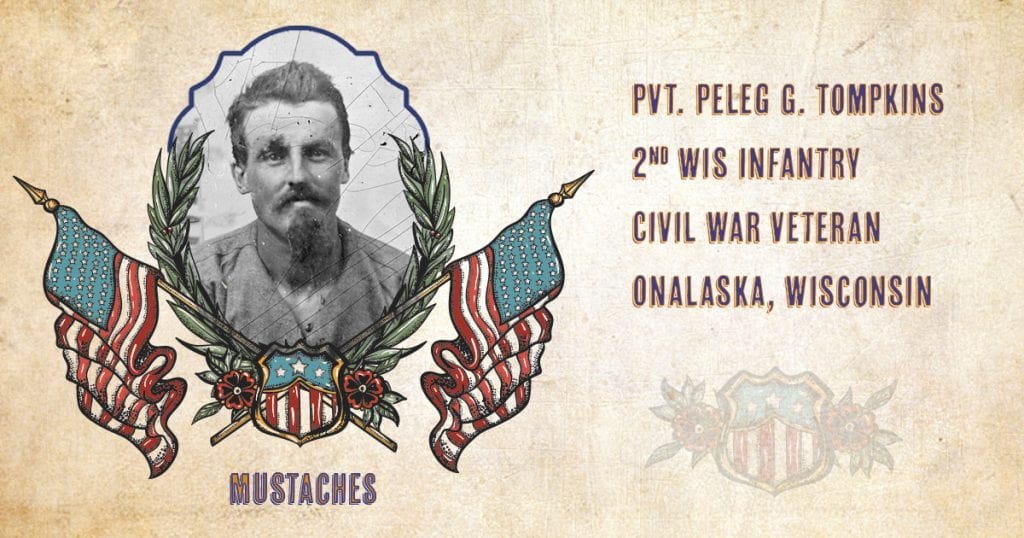
Private Peleg G. Tompkins
Peleg G. Tompkins was born on February 22, 1838 in New York. By 1860, he was living in Onalaska, Wisconsin and working as a carpenter. Standing 5’8” tall with grey eyes, brown hair, and a dark complexion, the twenty-three year old Tompkins enlisted into Company B, 2nd Wisconsin Infantry Regiment on April 18, 1861.
After training at Camp Randall in Madison, Tompkins and the 2nd Wisconsin traveled to Washington, DC in June and joined the Army of the Potomac. Initially placed in a brigade under the command of a little known (at the time) officer named William T. Sherman, the 2nd Wisconsin took part in the battle at Blackburn’s Ford and 1st Bull Run in July 1861. The very next month, Tompkins and the 2nd Wisconsin were reassigned to a new brigade, one that would see heavy action in all the major battles in the Eastern theater and earn the nickname Iron Brigade.
Tompkins, however, would not see much of the Iron Brigade’s action. In the spring of 1862, he was detached from the 2nd Wisconsin to work on the construction of bridges near Fredericksburg. After that, he put his skills as a carpenter to use by serving in the Division Construction Corps. Finally, in November 1862 he was permanently detached to the “Engineer troops,” in which he performed similar tasks. Tompkins’ three year term of service expired in June 1864 and he mustered out with his company in Madison.
Soon thereafter, married Susan Pattenson. The couple moved to Pennsylvania and Indiana before settling on a farm in western Arkansas in 1883, where they lived out the remainder of their lives. Tompkins passed away on February 7, 1916 and is buried at Murphy Cemetery in Montgomery County, Arkansas.

